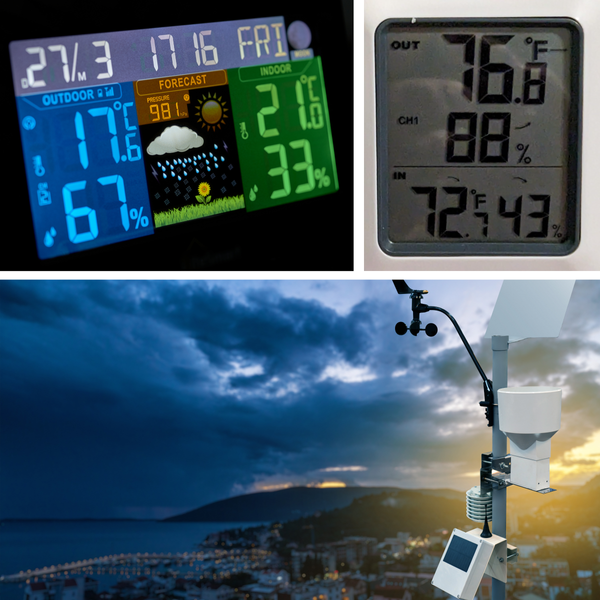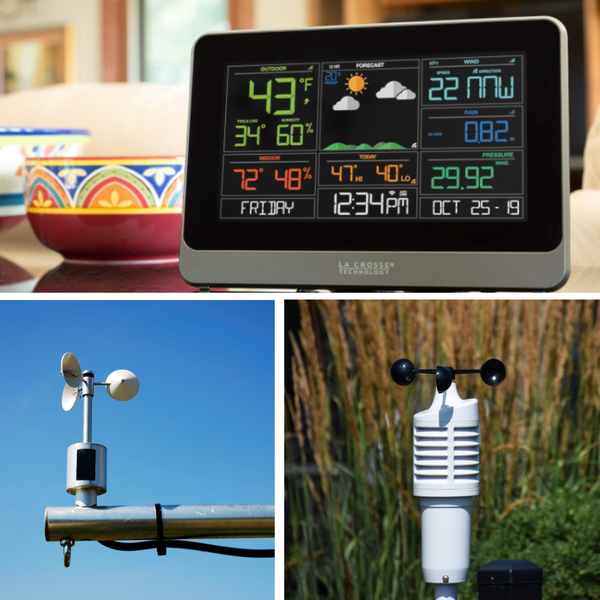Weather stations you can install at your own home have surged in popularity, driven by an increasing number of weather enthusiasts and the desire for hyper-local weather data. But how accurate are these personal weather stations, and can they really match up to the data provided by official sources? This comprehensive guide delves into the accuracy of home weather stations, exploring everything from sensor quality to environmental factors that could impact readings.
Key Takeaways:
- Accuracy Varies by Model: High-end weather stations often provide more accurate and reliable data compared to mid-range or basic models.
- Importance of Proper Setup: The accuracy of weather data heavily depends on how well the station is installed and its location.
- Technology and Connectivity: Advanced sensors and smart home connectivity can enhance the precision and ease of data collection and monitoring.
Understanding Weather Station Components
A typical home weather station includes various instruments like temperature sensors, humidity sensors, a barometer, a wind vane, and rain gauges. Each component plays a crucial role in measuring specific weather conditions. For instance, barometric pressure, which is crucial for weather prediction, is measured by the barometer, while the wind vane and anemometer measure wind speed and direction.

The Role of Sensor Quality
Not all weather stations are created equal. Higher-end weather stations usually come equipped with more sophisticated sensors that provide more accurate readings. For example, the Vantage Vue and Ambient Weather WS models are known for their reliable sensors that measure everything from solar radiation to heat index with a high degree of accuracy.
Installation and Location: Keys to Precision
The accuracy of a personal weather station significantly depends on its installation. Careful placement away from obstructions and reflective surfaces can prevent data anomalies. For instance, a temperature sensor placed in direct sunlight can report higher temperatures, skewing the weather data collected.
Comparing Home Stations to Official Data
While personal weather stations can provide valuable insights, it's important to compare their data with that from an official weather station. This comparison can sometimes reveal discrepancies due to the microclimates in just a few miles or even in your exact location, which official stations might not report.

Calibration and Maintenance
Regular calibration and maintenance are essential for keeping a home weather station accurate. Sensors can drift over time or get clogged, especially rain gauges and humidity sensors. Users should follow the manufacturer’s guidelines on maintenance to ensure their readings remain spot on.
Enhancing Weather Data with High-End Models
When diving into the world of personal weather stations, opting for a high-end model can significantly boost the accuracy and range of weather data collected. These sophisticated units often come equipped with a comprehensive sensor array that measures temperature, humidity, wind speed, and more. For instance, the best weather stations include features like a radiation shield to protect sensors from sunlight and heat, ensuring more accurate readings. This is particularly important for those who are passionate about meteorology or need precise weather information for professional reasons.
Moreover, high-end weather stations often feature enhanced connectivity options. These stations can send data directly to popular platforms like Weather Underground, allowing users to contribute to larger weather tracking networks. This connectivity not only helps in sharing data but also in receiving real-time updates and alerts from the community. For technology enthusiasts or those involved in data-driven professions, these features make high-end models a worthy investment, turning a simple home device into a powerful tool for both personal and communal benefit.
The Significance of Dew Point and Humidity Measurements
When diving into the world of home weather stations, understanding the importance of dew point and humidity measurements can be a game-changer. Dew point, which indicates the temperature at which air becomes saturated with moisture, is crucial for predicting fog and dew formation. A high-end weather station equipped with a precise humidity sensor can provide you with this valuable data, allowing you to anticipate weather changes more accurately. This is particularly useful for gardeners and homeowners who want to protect their plants from frost or excessive moisture.
Moreover, humidity plays a pivotal role in how comfortable you feel. A weather station that offers detailed humidity and dew point readings can help you manage your home environment more effectively. For instance, during a high humidity day, you might want to adjust your air conditioning settings to maintain comfort. By choosing the best home weather station that includes all the sensors necessary for these measurements, you ensure that you're not just getting data, but a comprehensive tool to enhance your daily life.

The Evolution of Barometer Technology in Weather Stations
High-end weather stations have revolutionized how we understand atmospheric pressure, with advanced barometer technology leading the charge. These devices provide not just readings but a window into weather patterns, helping us predict changes more accurately. For instance, a high-end model might use finely tuned sensors to detect slight variations in air pressure, which can indicate an approaching storm or a sunny day. This precision turns a simple barometer reading into a powerful tool for both amateur and professional meteorologists.
Exploring the Impact of Wind Chill and Rainfall Sensors
In the pursuit of the best weather station, considering devices that measure wind chill and come equipped with haptic rain sensors can provide a more complete meteorological picture. Wind chill, a crucial measurement for colder climates, helps determine how the wind and cold air combine to lower the temperature perception on the skin. A higher-end weather station that calculates wind chill can guide you on how to dress appropriately for outdoor activities during cold months, enhancing your comfort and safety.
Rainfall measurement, on the other hand, is not just about knowing how much it rained, but understanding the intensity and duration of rainfall. Stations with advanced haptic rain sensors capture these details more accurately, allowing for better planning and preparation for rainfall-related activities. Whether you're a technology journalist covering weather phenomena or a casual user interested in gardening, having a weather station that provides detailed insights into wind chill and rainfall can significantly improve your interaction with the elements.
Smart Home Compatibility and Weather Stations
Incorporating a weather station into your smart home setup can transform how you interact with both your indoor and outdoor environments. Stations with smart home support can seamlessly integrate with other smart devices, enabling automated actions based on real-time weather conditions. For example, if the rain gauge detects moisture, your smart irrigation system can pause watering the garden, saving water and preventing over-saturation. This integration not only makes managing your home more efficient but also enhances the comfort and adaptability of your living space.
Furthermore, the best home weather stations now come with features like internet connectivity and battery-operated bases, which allow for continuous monitoring and data collection even during power outages. This level of integration ensures that you stay informed about the weather conditions around your home, which can be crucial for planning daily activities or preparing for severe weather events. By choosing a station that supports smart home technology, homeowners can enjoy a more connected, responsive, and informed lifestyle.

Impact of Environmental Factors
Environmental factors like buildings, trees, and bodies of water can affect the readings from your own weather station. For instance, if a wind vane is too close to a building, it might not accurately measure wind direction due to eddies and gusts deflected by the building.
Smart Home Integration
With the rise of smart home devices, many personal weather stations now offer smart home connectivity. This feature allows for seamless integration with systems like Google Assistant, enabling easy access to weather data and automated home adjustments based on current weather conditions.
Choosing the Right Weather Station
When selecting a personal weather station, consider what weather elements are most important for you to track and your technical proficiency. High-end models like those from La Crosse Technology or the Davis Instruments Vantage Vue provide comprehensive weather data and are generally accurate, but they also require a more complex setup process.
The Accuracy of Optional Sensors
Optional sensors for elements like soil moisture or solar power can be added to many weather stations. These sensors can enhance the breadth of data collected but must be chosen and installed with precision to avoid data inaccuracies.

Weather App vs. Home Weather Station
While weather apps provide a convenient way to check local weather, they often do not offer the localized precision of a home-installed weather station. Apps typically pull data from broader areas, which might not reflect the microclimatic conditions of your specific locale.
The Future of Home Weather Monitoring
Advancements in technology continue to improve the accuracy and capabilities of home weather stations. Future models are likely to offer even more precise sensors and better integration with home automation systems, providing both enthusiasts and casual users with rich, accurate weather data.
Summary
Home weather stations can be a valuable tool for anyone interested in the specific climate conditions of their immediate environment. While the accuracy of these devices varies depending on factors like model quality, installation, and maintenance, modern high-end weather stations are capable of providing data that is very close to official readings. Proper setup and regular calibration are crucial to ensure the best performance from your weather monitoring equipment.
FAQ
Q: Can a home weather station replace official weather data sources?
A: While home weather stations provide detailed local data, they should complement rather than replace official sources, which include data collected from multiple points and are used for broader meteorological analyses and predictions.
Q: How often should I calibrate my home weather station?
A: Calibration frequency can vary by model and manufacturer, but generally, it is good practice to check and calibrate your weather station at least once a year to ensure accuracy.
Q: Are there weather stations that don’t require complex setup?
A: Yes, there are several models designed for ease of use with minimal setup requirements, such as certain mid-range units from brands like AcuRite. These are ideal for casual users who prefer a simpler approach to weather monitoring.










